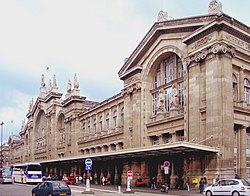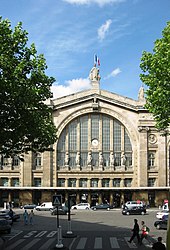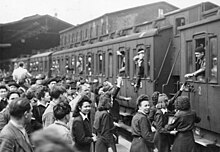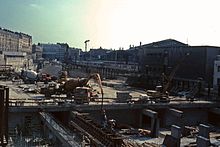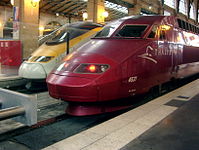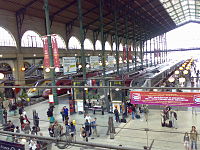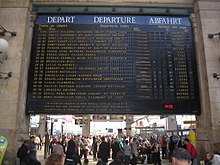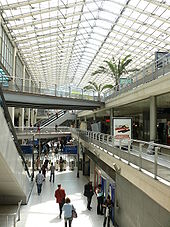Paris-Nord train station
| Gare du Nord | |
|---|---|
|
Main entrance to the train station
|
|
| Data | |
| Design | Terminus |
| Platform tracks | 31 (including 4 in the basement) |
| IBNR | 8700014 |
| opening | June 20, 1846 |
| Architectural data | |
| architect |
Jakob Ignaz Hittorff (remodeling 1861–1866) |
| location | |
| City / municipality | Paris |
| Department | Paris |
| region | Île-de-France |
| Country | France |
| Coordinates | 48 ° 52 '58 " N , 2 ° 21' 24" E |
| Railway lines | |
| List of train stations in France | |
The Paris-Nord train station ( French: Paris Gare du Nord ) is located in the 10th arrondissement of Paris on Place Napoléon III. and is the busiest train station in Europe and the third largest in the world. Every day at this railhead about 700,000 passengers handled (as of 2015). Trains run from here to four countries: Great Britain, the Netherlands, Belgium and Germany.
history
19th century
The North Station was the central station of the Compagnie des chemins de fer du Nord , which was founded by the banking houses Rothschild Frères , Paris, and NM Rothschild & Sons , London . The first station went into operation on June 20, 1846. It was called the Embarcadère du Chemin de Fer du Nord . The station area covered 12,000 square meters and only two tracks led into the station concourse - according to the handling procedure common in the early days of the railway industry: one for arriving trains, the other for departing trains. With the rapidly growing traffic, such a station could no longer cope with the volume of traffic. As early as 1854, during the state visit of Queen Victoria, her court train had to be diverted at the last minute to the nearby Paris-Est train station (Gare de l'Est) .
The responsible ministry gave permission to build a larger train station. The specifications stipulated that a clock had to be installed in the outer facade and that the new station should meet current and future requirements. The president of the railway company, James Mayer Rothschild , commissioned the Cologne-based architect Jakob Ignaz Hittorff (with the assistance of Heinrich Köhler ), who lives in Paris, with the planning. Construction began in May 1861. The station was opened on April 19, 1864 during the construction work, although the station building was not completed until December 1865. At the beginning there were eight tracks in the new station. The center of the 180-meter-long grand facade was a large glazed arch. The facade was in 1975 as a monument historique under monument protection provided. The building has the usual U-shape of a terminal station , the central hall has a ridge height of 30 meters. The station area covers an area of 3.6 hectares, three times as much as the previous facility. The facade of the former Belgian station was to Lille translocated and there, supplemented by an additional floor and a clock tower , a wall of the station Lille-Flandres second used.
The world exhibitions of the late 19th century were the reason to build more tracks and platforms in line with the increased volume of traffic - between 1875 and 1889 alone the number of travelers rose from six to ten million a year. On the occasion of the World Exhibition of 1889 , the number of tracks was increased from 13 to 18, and ten more tracks were added for the World Exhibition of 1900 . The tracks were structured in four groups: tracks 1 to 5 served as departure tracks for long-distance lines, tracks 6 to 13 for suburban traffic (in the direction of Pontoise , Valmondois , Montsoult ). The trains from the long-distance lines arrived on tracks 14 to 19. Tracks 20 to 24 served the routes via Soissons , 25 to 28 for local traffic and later also for the Petite Ceinture trains .
First half of the 20th century
The importance of the Gare du Nord as a transport hub increased further when the metro line 5 reached the station in 1906 and its line 4 in 1908 . Luxury trains also ran in the Gare du Nord. These included the Nord-Express , the Flèche d'or and Night Ferry - the latter two to London .
The 1930s brought improvements in the track apron : By building several bridges , it was possible to better separate the individual track groups from one another and to avoid track crossings. In the area of the municipality of Villetaneuse , the Dépôt des Joncherolles was built, in which suburban trains could be parked.
With the beginning of the Second World War in September 1939, the number of travelers in Paris-Nord fell drastically: international rail traffic came to a standstill and the number of trains on French long-distance and regional lines was also considerably reduced.
The German Wehrmacht used the station to a large extent for their traffic between occupied France, northern Germany and Belgium from 1940 to 1944. From June 1942 to July 1944, in connection with the establishment of the Service du travail obligatoire (compulsory labor service, STO), 600,000 to 650,000 young French were forcibly transported to Germany, most of them via the Paris-Nord train station. After the end of the war, the freed French prisoners of war , abducted persons and forced laborers returned largely via the Paris-Nord train station.
An air raid by American and British bombers on the night of April 21-22, 1944, a preparatory measure for the Allied landings in Normandy , caused great damage to the apron . The aim was to destroy the Wehrmacht's supply routes. The actual target of the air raids that night were the railway depot and workshops of La Chapelle, near the Porte de la Chapelle . The bombs fell north of the Pont Marcadet, a bridge about 600 meters north of the station. Overpass structures and signal boxes were destroyed. The rail traffic between Paris-Nord, Saint-Denis and Aubervilliers-La Courneuve was initially completely interrupted. In the following weeks it was possible to get the traffic going again on a makeshift basis.
electrification
The electrification of the railway lines in northern France carried out in the 1950s and 60s also brought important innovations to the Gare du Nord from 1957: Platforms 1 to 5 and 15 to 19, reserved for long-distance trains, were uniformly extended to 400 meters. In 1958 a relay interlocking was built to replace several mechanical interlockings . In order to relieve the station during construction, the trains from Beauvais were diverted to Saint-Lazare station in 1957/58 .
The electrification emanating from Lille reached Paris in 1958: The overhead lines were energized on December 9, 1958 (25 kilovolts): Although the track area of the station was completely electrified, suburban traffic was operated with steam locomotives for a few years .
The RER train station
For the Réseau express régional d'Île-de-France (RER), the Ligne de Sceaux was extended underground from the Luxembourg train station to the Paris-Nord train station in order to link it there with the line to Mitry-Claye . For this new north-south connection ( line B of the RER ), the station on its eastern edge was expanded from 1977 to 1981 by a four-track underground section, which later also accommodated the trains on line D of the RER . As a result, the tracks for regional traffic disappeared from the main hall, which created space for the TGV Nord and the expansion of the train connections to the Grande couronne of the Île-de-France . An excavation pit more than 300 meters long and 50 meters wide was created using the cut-and-cover method. The train traffic was not allowed to be significantly impaired. Only three tracks of the connection to Mitry and a no longer needed baggage handling hall were given up for the construction.
The underground train station is two-story. Four tracks run on the lower floor for the two RER lines, with a platform 14 meters and one 17 meters wide in between. The mezzanine level above is a large foyer that allows travelers to pass between different train station areas as well as the metro and bus stops.
Expansion for high-speed traffic
For the use of the TGV trains on the LGV Nord, which opened in 1993, and for the Eurostar trains from 1994 onwards, various construction measures and changes in the operational sequence were unavoidable in the Paris-Nord station, as the number of passengers increased by 21 after the route and the Eurotunnel went into operation was calculated to be 36 million per year. Among other things, an underground multi-storey car park with 1,300 parking spaces for passenger cars was created, as well as control and clearance facilities for travelers to London. The use of the station tracks has also been reorganized, with the 13 platforms in the main hall being extended to 405 meters. The local trains in the direction of Montsoult were relocated from the main hall to the edge of the track field. The track apron has been optimized: flyover structures ensure a better separation of the main lines and the tracks to the Landy depot , which is responsible for the maintenance of the TGV trains. A new electronic signal box with 460 stored connections was built. It controls signals and points between the station and the start of LGV Nord, fifteen kilometers further north near Gonesse . A fifth track was laid as far as the junction of the LGV Nord from the Grande Ceinture near Stains in order to better separate the traffic flows.
Todays situation
Track occupancy
The track area is now divided into four segments that are operationally independent of each other:
- Thalys and Eurostar trains
- Intercités and TGV
- Local transport network of the TER lines
- RER network and Transilien network
The following classification applies:
- Track 1: siding for trains waiting to be deployed
- Track 2: siding for trains waiting to be deployed, siding in the event of operational disruptions
- Tracks 3 to 6: Terminal Eurostar to London using the Eurotunnel . These tracks are separated from the rest of the station with a fence.
- Tracks 7 and 8: Thalys trains to Belgium, Germany and the Netherlands
- Tracks 9 to 18: TGV Nord, long-distance trains and some Picardy regional trains
- Tracks 16 to 21: Regional trains Picardie TER Picardie
- Tracks 30 to 36: Regional trains to Ile-de-France: Transilien
- Tracks 41 to 44 (underground): local trains of the RER network ( RER B and RER D )
The tracks of the Magenta train station , which is in close proximity to Paris-Nord, carry the numbers 51 to 54 in continuity with those of the Gare du Nord.
The train volume
2100 trains depart every day and transport up to 700,000 people. There are connections to regional and inner-city transport via three RER lines, three metro lines, twelve bus lines and seven night bus lines of the Noctilien network. 85 percent of the passenger volume is made up of local transport passengers.
Expansion from 2019 to 2024
The station is to be fundamentally rebuilt and expanded by 2024, whereby its area is to be tripled. The costs are estimated at around 600 million euros . To implement the project, the subsidiary of the state-owned railway company SNCF , which is responsible for the stations, has founded a joint venture called Semop, in which Ceetrus holds 66% of the shares, together with the private company Ceetrus, a subsidiary of the Auchan department store chain . During the expansion, the station is to be supplemented with a new wing of the building with a departure terminal and a shopping center. In the previous station building, only arriving trains are to be processed. In March 2019, Semop started a public survey; Once the building permit has been granted, work should begin at the end of 2019 or beginning of 2020 and be completed between June 2023 and March 2024.
Connection
Grandes lignes (long-distance transport)
International
- Eurostar to London
- Thalys to Brussels (one pair of trains to Ostend ), Amsterdam and Cologne (three pairs of trains to Dortmund ).
National
- TGV to Lille and Arras
- Intercités connections to Boulogne-sur-Mer and Maubeuge / Cambrai
- Lines of the TER Picardy
Regional traffic
- The station is the starting point of the Transilien routes Paris Nord for regional and local transport, i.e. the Transilien lines H and K in the direction of Beauvais , Compiègne , Crépy-en-Valois and Pontoise .
- The RER lines B and D stop in the underground station (French: gare souterraine ) . The Magenta station on the RER E is also connected to the station .
city traffic
Lines 4 and 5 of the Paris Métro stop at the station . The station La Chapelle of the line 2 can be reached via a pedestrian corridor.
Trivia
- Eight statues of women on the facade of the station symbolize important travel destinations: Brussels , Amsterdam , London , Vienna , Berlin , Warsaw , Cologne and Frankfurt am Main . However, trains never left Paris-Nord station for Frankfurt and Vienna. Trains with these destinations used the Paris-Est station (Gare de l'Est) .
- The station has been the setting for several films, including The Bourne Identity , The Fabulous World of Amélie , Less Alone Together and Mr. Bean's vacation .
- The station is mentioned in the song Polaris by the American rock band Jimmy Eat World , as well as in the song Der Malocher by Udo Lindenberg .
literature
- Wolfgang Klee, Stefan Vockrodt: Gare du Nord: the largest of the big ones . In: Railway history special 2 . Railways in Paris. 2015, ISBN 978-3-937189-94-9 , pp. 16-21 .
Web links
- SNCF station information (French)
- Paris-Nord train station. In: Structurae
- www.paris.org: Gare du Nord (English, French) ( Memento of December 5, 1998 in the Internet Archive )
Remarks
- ↑ Embarcadére stands in French for "ship landing stage" or "landing stage". The term was used for departure / arrival points of railways in the early days of the railway industry. Later the term gare became popular .
Individual evidence
- ^ Paris Gare du Nord. In: gares-sncf.com. Retrieved on March 24, 2018 (French, railway station operator in France).
- ↑ a b c Richard Deiss: Impeller cathedral and sugar beet station . A short story about 200 European train stations. Bonn 2010, p. 46 .
- ↑ a b c press release from the SNCF. (PDF) June 24, 2015, accessed June 26, 2015 (French).
- ↑ Database entry at structurae.de
- ↑ Deiss, p. 47.
- ↑ Third TGV line opened . In: Railway technical review . tape 42 , no. 7/8 , 1993, pp. 432 .
- ^ Paris: une concertation avant la transformation de la Gare du Nord. In: francetvinfo.fr . March 1, 2019, accessed June 19, 2019 (French).
